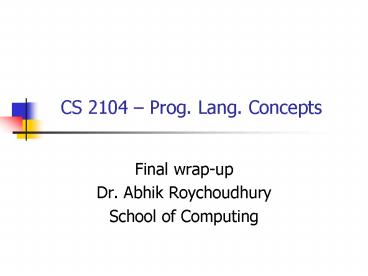CS 2104 - PowerPoint PPT Presentation
Title: CS 2104
1
CS 2104 Prog. Lang. Concepts
- Final wrap-up
- Dr. Abhik Roychoudhury
- School of Computing
2
Cuts
A cut prunes an explored part of a Prolog search
tree.
a(1) - b. a(2) - e. b -
c. b - d. d. e.
!,
!,
?- a(X). X 1 X 2 no
?- a(X). X 2 no
Cut in a clause commits to the use of that
clause. Cut has the effect of making b fails if c
fails.
3
a(X) -b(X). a(X) -f(X). b(X) -g(X),
v(X). b(X) -X 4, v(X). g(1). g(2). g(3). v(1)
. v(X) - f(X). f(5).
!,
?- a(Z). Z 1 Z 5 no
?- a(Z). Z 1 Z 5 no
4
Green Cuts, Red Cuts
- Green Cut
- a cut the prunes part of a Prolog search tree
that cannot possibly reach a solution - used mainly for efficiency sake.
- Red Cut
- a cut that alters the set of possible solutions
reachable. - Powerful tool, yet fatal and can be confusing
- Handle with care
5
Merging two lists
- merge(XXs,YYs,XZs) - X ltY,
merge(Xs,YYs,Zs). - merge(XXs,YYs,X,YZs) - X Y,
merge(Xs,Ys,Zs). - merge(XXs,YYs,YZs) - X gt Y,
merge(XXs, Ys, Zs). - merge(X, , X).
- merge(, Y, Y).
- First three clauses mutually exclusive
- No need to try the others, if one of them
succeeds. - This is made explicit by a green cut.
6
Example Green cut
- merge(XXs,YYs,XZs) - X ltY, ! ,
merge(Xs,YYs,Zs). - merge(XXs,YYs,X,YZs) - X Y, ! ,
merge(Xs,Ys,Zs). - merge(XXs,YYs,YZs) - X gt Y, ! ,
merge(XXs, Ys, Zs). - merge(X, , X) - ! .
- merge(, Y, Y).
- Inserting these cuts does not change the answers
to any merge query.
7
Example Red Cut
- member(X,XXs) - ! .
- member(X,YYs) - member(X, Ys).
- member(1, 1,2,1,1,3) is more efficient.
- But member(X, 1,2,3) produces only one answer
- X 1
8
Summary
- Prolog is a procedural language with
- Assign once variables
- Nondeterminism
- As a result of having assign once variables
- Assignment is symmetric
- Test and assignment represented by same operator.
- Unification combines the concepts of test,
assignment and pattern matching.
9
Summary
- As a result of having nondeterminism
- Control issues for the search
- Cuts (allows the programmer explcit control)
- Meaning of Prolog program given by queries that
can be evaluated to true. - Applications of Prolog
- Database query language
- Grammar Processing, Natural Language Processing
10
Homework 10
- mergesort(, ) - !.
- mergesort(A, A) - !.
- mergesort(L, L1) - split(L, M, N),
- mergesort(M, M1),
- mergesort(N, N1),
- merge(M1, N1, L1).
- split(, , ).
- split(A, A, ).
- split(A,BRest, AM, BN) - split(Rest, M,
N).
11
Homework 10
- Replacing an element in a list
- replace(X, Y, XRest, YRest) - !.
- replace(X, Y, ZRest, ZList) -
- replace(X, Y, Rest,
List).
12
Homework 10
- Removing duplicates in a list
- remdup(L, L1) - remdup(L, , L1).
- remdup(, L, L).
- remdup(XXs, SoFar, List) -
- member(X, SoFar), !, remdup(Xs,
SoFar, List). - remdup(XXs, SoFar, List) - remdup(Xs,
XSoFar, List).
13
Homework 10
- What happens for query find(X)
- find(X) - not(p(X)).
- p(X) - q(X), r(X).
- q(f(X)) - q(X), X \ b.
- r(X) - X \ a
14
Homework 10
p(X)
find(X)
Query eval. Does not terminate
q(X), r(X)
not(p(X))
q(X1), r(f(X1))
q(X2), r(f(f(X2)))
15
Answers for last years final exam posted in
course web-site. Look under -gt Materials -gt
Other Resources
16
Thank You































